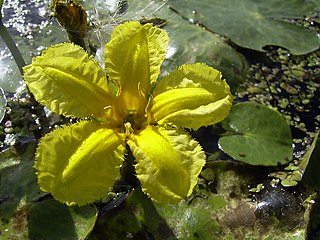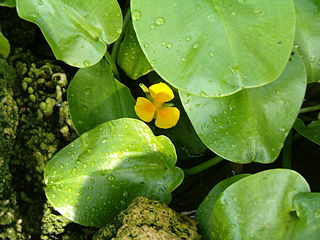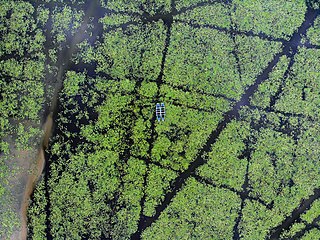Water lily or water lilies may refer to:

Stratiotes is a genus of submerged aquatic plant commonly known as water soldiers, described as a genus by Linnaeus in 1753. Several specific names have been coined within the genus, but at present only one is recognized: Stratiotes aloides. native to Europe and NW Asia.

Menyanthaceae is a family of aquatic and wetland plants in the order Asterales. There are approximately 60-70 species in six genera distributed worldwide. The simple or compound leaves arise alternately from a creeping rhizome. In the submersed aquatic genus Nymphoides, leaves are floating and support a lax, umbellate or racemose inflorescence. In other genera the inflorescence is erect and consists of one to many flowers. The sympetalous, insect-pollinated flowers are five-parted and either yellow or white. The petals are ciliate or adorned with lateral wings. Fruit type is a capsule.

Nymphoides, or floatingheart, is a genus of aquatic flowering plants in the family Menyanthaceae. The genus name refers to their resemblance to the water lily Nymphaea. Nymphoides are aquatic plants with submerged roots and floating leaves that hold the small flowers above the water surface. Flowers are sympetalous, most often divided into five lobes (petals). The petals are either yellow or white, and may be adorned with lateral wings or covered in small hairs. The inflorescence consists of either an umbellate cluster of flowers or a lax raceme, with internodes occurring between generally paired flowers.

Brasenia, commonly known as watershield, is a genus belonging to the family Cabombaceae, consisting of one species, Brasenia schreberi. It is widely distributed in North America, the West Indies, northern South America, eastern Asia, Australia, the Indian Subcontinent, and parts of Africa.

Nymphoides peltata is perennial, rooted aquatic plant with floating leaves of the family Menyanthaceae.

Nymphoides aquatica is an aquatic plant in the Menyanthaceae, native to the southeastern United States from Texas to Maryland. It is known variously as the banana plant, banana lily, and the big floatingheart. It is most commonly called the banana plant because of its banana-shaped roots. These unusual roots store nutrients.

Nymphoides hydrophylla, commonly known as crested floating-heart, is an aquatic plant of the family Menyanthaceae native to tropical Asia. It has cordate floating leaves that support a lax inflorescence of dainty white flowers with fringed petal margins. Its slim stem (spear) is edible, and is used as vegetable in Taiwan, mostly produced at Meinong District, Kaohsiung.

Hydrocleys is a genus of aquatic plants in the Alismataceae, native to the Western Hemisphere, though one is naturalized elsewhere and sold as an ornamental for decorative ponds and artificial aquatic habitats. At present, five species are recognized:

Hydrocleys nymphoides, the waterpoppy or water-poppy, is an aquatic plant species in the Alismataceae. It is widespread across South America, Central America, Puerto Rico, Trinidad and the Netherlands Antilles. It is cultivated in many places for used in decorative ponds and artificial aquatic habitats, and naturalized in Australia, New Zealand, South Africa, Fiji, New Caledonia, French Polynesia, Florida, Louisiana and Texas.
Parapoynx seminealis, the floating-heart waterlily moth, is a moth in the family Crambidae. It was described by Francis Walker in 1859. It is found in North America, where it has been recorded from Florida, Georgia, Massachusetts, Mississippi, New Hampshire, Rhode Island, South Carolina and Texas.
Eriocaulon sivarajanii is a critically endangered monocotyledonous plant endemic to Kozhikode in the state of Kerala, India.
Nymphoides macrospermum is a critically endangered aquatic plant of the family Menyanthaceae endemic to Alwaye in Kerala, India. It is an annual herb which has been observed in paddy fields, lagoons and slowly flowing streams. It is dioecious, with male and female flowers on separate plants.

Nymphoides indica is an aquatic plant in the Menyanthaceae, native to tropical areas around the world. It is sometimes cultivated, and has become a minor weed in Florida, where it resembles the native Nymphoides aquatica. Common names include banana plant, robust marshwort, and water snowflake; {In Bengali: চাঁদমালা (Chandmala)}.

Nymphoides geminata, commonly known as entire marshwort, is an aquatic plant of the family Menyanthaceae native to eastern Australia.

Nymphoides crenata, commonly known as wavy marshwort, is an aquatic perennial herb of the family Menyanthaceae endemic to Australia, found in all mainland states and the Northern Territory

Diphlebia nymphoides is a species of Australian damselfly in the family Lestoideidae, commonly known as an arrowhead rockmaster. It is endemic to eastern Australia, where it inhabits streams and rivers.

Kondakarla Ava is a famous Lake and Bird Sanctuary in Visakhapatnam of Andhra Pradesh state in South India. It comprises a unique and endangered forest type. It is located in the foothills of Eastern Ghats.
Hail Haor Wildlife Sanctuary is a major wildlife sanctuary in Bangladesh. It is one of the most important wetlands in the Sylhet Basin for the resident and migratory waterfowls. It is also important watersource for the inhabitants living around when all other sources dry up during summer. The sanctuary is located in Moulvibazar District, in the northeast region of the country.














